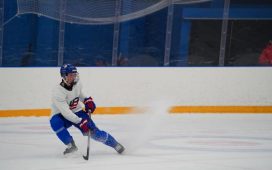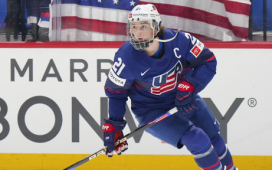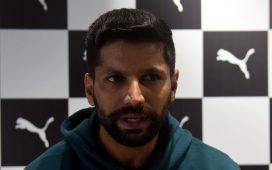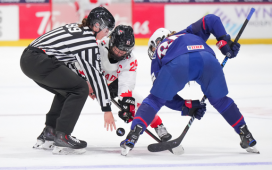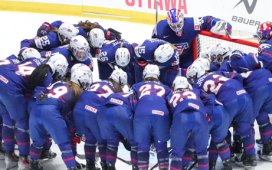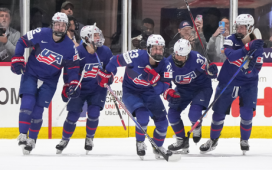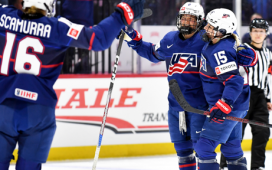It’s still unknown when the 2019-20 NHL season will resume, but it’s carved in stone exactly how the season will play out if it resumes. Last week’s official announcement of the 24-team tournament confirmed the end of the season for the bottom seven teams in the league in points percentage: four in the East and three in the West.
It’s time, then, to pour one out for each of the teams done playing this season. What went wrong? What went right? What happens next?
We start with the Detroit Red Wings (17-49-5), who posted the lowest points percentage since the 1999-00 Atlanta Thrashers. Year 1 under new GM Steve Yzerman was a true tank job, with the Wings keeping most of their top prospects vacuum-sealed in the minors.
WHAT WENT WRONG
The Wings scored a league-low 2.00 goals per game. They allowed a league-high 3.73 goals per game, the most by any team since 1999-00. They had the league’s worst penalty kill and 29th-best power play. They averaged the fewest shots per game and allowed the fifth-most. They sat dead last in 5-on-5 Corsi. They generated the fewest scoring chances for and allowed the second-most scoring chances against per 60. They were almost undisputedly worst NHL team of the past two decades.
And there’s a strong case to be made that was entirely by design. After Yzerman took over last off-season, he counted aging center Valtteri Filppula as the team’s biggest off-season addition. When the 2019-20 regular season began, Detroit kept most of its top prospects in the AHL, from Moritz Seider to Filip Zadina to Joe Veleno, and even demoted Michael Rasmussen, who’d made the team the previous season. Only a husk of roster was left to toil in the NHL. The Wings had a strong top line in Tyler Bertuzzi, Dylan Larkin and Anthony Mantha, but it got grim after that, weighed down by ugly contracts from the end of the Ken Holland era. Darren Helm, Frans Nielsen and Justin Abdelkader ate $13.35 million of cap space and delivered a combined 13 goals.
WHAT WENT RIGHT
The top line was legit. Tyler Bertuzzi has matured into a solid power forward, even getting an All-Star Game invite this season and surpassing 20 goals a second consecutive year. That Dylan Larkin managed to secure better than a 50 percent shot-attempt share at 5-on-5 on a team this bad is a testament to his maturation as a two-way forward. Anthony Mantha would’ve led the team in most offensive categories had he not missed 28 games with knee and lung injuries.
After starting the season in the minors, Zadina, chosen sixth overall in the 2018 draft, got his NHL call-up in late November. He started slowly but gained confidence and managed eight goals in a 21-game stretch before an ankle injury derailed his season. It was an encouraging sign for a prospect who was rated as high as top-two at one point during his draft year and drew Marian Hossa comparisons.
Filip Hronek was a bright spot on the blueline, too. He still watched plenty of pucks go into his own team’s net when he was on the ice, so the defensive side of the game needs work. Among 99 blueliners who played at least 1,000 minutes at 5-on-5, he averaged the 10th-most giveaways per 60 minutes. But he played more than 23 minutes a night, showcased a big shot, managed nine goals and established himself as a power-play quarterback Detroit can build around.
TEAM MVP
Larkin continues to use his elite speed to cover a ton of ice and handle his defensive assignments relatively well on the worst NHL team in 20 years, he was the engine driving the team’s best line, he was strong on faceoffs, and he’s a pretty easy choice to be Detroit’s next captain.
MAJOR MOVES
Yzerman made a nice splash landing injury-prone fallen first-rounder Robby Fabbri from the St. Louis Blues straight up for Jacob De La Rose in November. Fabbri, still just 24, had 14 goals and 31 points in 52 games with the Wings. He was practically the lone source of secondary scoring among the forward group. Excluding players on entry-level deals, Fabbri delivered the eighth-best cost per point in the NHL this season on his $900,000 cap hit.
Yzerman possessed no available asset good enough to net him a first-round pick at the 2020 trade deadline, but he did turn Andreas Athanasiou and Mike Green into a couple second-round picks and a conditional 2020 fourth that could become a 2021 third if the Edmonton Oilers reach the Western Conference final and Green plays 50 percent of the games.
DRAFT DAY
The Red Wings enter the 2020 draft with nine or 10 picks, depending on whether the Green trade triggers conditions. On top of their first-rounder, they own three selections in the second round of a deep draft class.
As NHL commissioner Gary Bettman outlined last week, the first round of the draft lottery runs June 26 – and will conclude June 26 if bottom-seven teams are drawn for all three lottery spots. The Red Wings on paper have the top odds at 18.5 percent but really have the second-best odds with the Ottawa Senators holding their pick plus the San Jose Sharks’ pick and climbing to 25 percent.
So maybe the Wings get ready-made star left winger Alexis Lafreniere first overall. If they don’t, everyone from No. 2 on is not a lock to jump right to the NHL, but it would certainly be possible for the man-child center Quinton Byfield or speedy sniper Tim Stutzle. Detroit can’t fall any lower than fourth overall and should land a big-time prospect in that tier, be it Stutzle, dynamic D-man Jamie Drysdale, Lucas Raymond or scoring machine Marco Rossi.
PROSPECTS
The Wings have potential to turn over their roster drastically from 2019-20 to 2020-21. There’s a chance whomever they pick first in 2020 goes right to the NHL as a Calder Trophy threat, and they’ll have another in towering defenseman Moritz Seider, the first pick of the Yzerman era. He was seen as a reach at No. 6 overall in 2019 but, a year later, he looks more like a steal. He’s an absolute horse of a top-pair defenseman who can play in all situations. He skews more on the shutdown side but could develop offense as he matures. He has a strong chance to make the Wings’ lineup and immediately be their best defenseman next season. With a full season of a healthy Zadina and potential to see center Rasmussen and demoted defenseman Dennis Cholowski up for good next season, the Wings should be much younger and more dynamic.
SALARY-CAP SITUATION
We’re finally starting to see some big contracts come off the books. Defenseman Jonathan Ericsson and Trevor Daley and goalie Jimmy Howard go UFA. That trio alone clears more than $11 million in cap space, which is good timing given there’s a strong chance the cap stays flat at $81.5 or shrinks given the COVID-19-related revenue losses.
With a flat cap, Detroit would have about $35 million in cap space. Even with RFAs Bertuzzi and Fabbri needing new pacts, Yzerman will have a chance to really put his stamp on this team – and it won’t be forcing it, as he only has 11 players signed for 2020-21, meaning he has no choice but to fill out this roster. Is the stage set to bring in UFA Torey Krug? He’s a Michigan boy who idolized the Red Wings during Yzerman’s playing days, the Boston Bruins are tight for cap space, and the Wings have very few NHL defensemen signed for next year. It’s Hronek, Danny DeKeyser, Patrik Nemeth, Seider and fringe guys like Madison Bowey. Krug would be a perfect fit.
Want more in-depth features, analysis and opinions delivered right to your mailbox? Subscribe to The Hockey News magazine.
